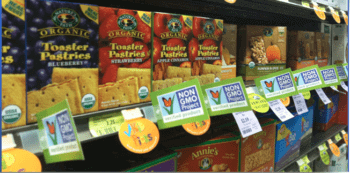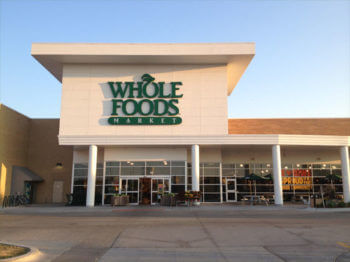The last example is perhaps the most ironic, as Starbucks has been in the cross-hairs of the most paranoid anti-GMO activists, who imagine the coffee chain working in concert with Monsanto to poison the world. One example is Vani Hari, also known as “The Food Babe”. Notorious for saying, “If you can’t pronounce it, don’t eat it”, she refers to the milk at Starbucks as “Monsanto milk.” But Hari is modest compared with Neil Young, whose 2015 album The Monsanto Years includes a song devoted to attacking Starbucks, Monsanto, and GMOs all in one rant.
If even Starbucks and other establishments that are regularly attacked by GMO-haters are willing to display products with the non-GMO seal, we might suspect the seal offers some advantage to somebody. But the truth is, it doesn’t benefit anybody — not the consumers, the stores or the food companies that pay for the verification.
Non-GMO Project label deceives consumers
GMO opponents routinely urge followers to choose products with the orange butterfly as a means of avoiding GMOs. This practice is deceptive for a couple of reasons. The first is that the desire to avoid GM foods depends on consumers believing two myths:
1) “GMOs” pose a danger to human health because of the selected transfer of genes between species.
2) Food made from transgenic crops contains higher, more dangerous pesticide levels than non-GMO food, which is to say food made from crops that were genetically modified through older technologies, such as hybridization and radiation mutagenesis.
The second reason is that the verification was not devised as a means of avoidance of GM crops. Consumers might find this surprising, partly because the label was designed with the term “NON-GMO” in bold all caps.
 When you see a Non-GMO seal on a food product, it actually means two things. The first is that the food company has paid the fees for its product to get “verified”. Second, it means the Non GMO Project has used the polymerase chain reaction (PCR) technique to amplify segments of extracted DNA, and then has analyzed that DNA for sequences specific to any of a handful of GMOs that are currently on the market.
When you see a Non-GMO seal on a food product, it actually means two things. The first is that the food company has paid the fees for its product to get “verified”. Second, it means the Non GMO Project has used the polymerase chain reaction (PCR) technique to amplify segments of extracted DNA, and then has analyzed that DNA for sequences specific to any of a handful of GMOs that are currently on the market.
A food product earns the seal of approval, if the testing shows that the telltale genetic sequences are not present above a certain threshold. That’s notably more permissive compared with kosher certification and various other seals that are designed to convey a state of purity. Rarely will you hear a GMO-avoidant consumer talking about thresholds, or a food marketer introducing a “low-GMO” or “reduced-GMO” food. But the limitation is admitted clearly in the fine print, on the Non-GMO Project website, as follows:
Unfortunately, “GMO Free” and similar claims are not legally or scientifically defensible due to limitations of testing methodology. In addition, the risk of contamination to seeds, crops, ingredients and products is too high to reliably claim that a product is “GMO Free.” The Project’s claim offers a true statement acknowledging the reality of contamination risk, but assuring the shopper that the product in question is in compliance with the Project’s rigorous standard.
One might also point out that “contamination” can happen, not only from mixtures of seeds, crops, and ingredients, but also as a result of DNA transferring between organisms –a phenomenon that occurs constantly in nature. This reality of nature renders the term “genetically modified organism” –and thus the terms “non-GMO” and “GMO-free”– utterly meaningless. That’s the real reason it’s not possible to make a “GMO-free” claim, but not a reason that the Non GMO Project is willing to admit, even in the fine print. But printed or not, the fact that all food is genetically modified makes the next part of the caveat all-the-more absurd:
While the Non-GMO Project Verified seal is not a “GMO free” claim, it is trustworthy, defensible, transparent, and North America’s only independent verification for products made according to best practices for GMO avoidance.
Will businesses profit if they promote the NGP seal?
If you’re the manager of a Whole Foods store, the motivation for lining your shelves with Non-GMO verified products is understandable. A certain fraction of the shoppers in there –probably a fairly high fraction– are looking for the seal.. The same is true for the manager of a standard supermarket that has a woo section for the purpose of competing with Whole Foods.
But consider a store manager who has been carrying the same potato chips, apple sauce,frozen goods and other items for the past 10 years. She may not even have noticed the new label when it appeared on the package. She may not even notice — and probably won’t care as long as it doesn’t force a change in customer buying habits.
This brings us to the food companies whose executives are making the decision to jump on the anti-science bandwagon. Do they expect this to increase profits, or are they just hoping to avoid becoming the target of a boycott?
As far as the money goes, the Non-GMO Project has various surrogates raving about how sales of verified products have been skyrocketing since 2013, supposedly approaching $20 billion now. They say that it’s mostly because consumers are increasingly aware of GMOs and have a need for “approval that they can trust”.
 But there’s a much simpler explanation, namely that an increasing number of products that people have been purchasing are getting the label. Maybe, this is due to speculation by food company executives that the label will boost sales. Whatever the reason, the label adorns many more food products than it did four years ago, and as noted above the store owners and managers just keep buying the items as usual. Today, the orange butterfly is on so many packaged items that it actually takes a conscious effort to avoid buying those “verified” foods, so of course sales of products with the verification are rising.
But there’s a much simpler explanation, namely that an increasing number of products that people have been purchasing are getting the label. Maybe, this is due to speculation by food company executives that the label will boost sales. Whatever the reason, the label adorns many more food products than it did four years ago, and as noted above the store owners and managers just keep buying the items as usual. Today, the orange butterfly is on so many packaged items that it actually takes a conscious effort to avoid buying those “verified” foods, so of course sales of products with the verification are rising.
Now, let’s turn to the matter of the damage. Companies are throwing away money of course, for the verification fees, the new packaging, and all the advertising and branding of their new anti-GMO image. CEOs of such companies may not put much thought into the possibility that to the small –but hopefully growing– segment of biologically-literate consumers they are branding themselves as science deniers. Right now, pandering to the ignorance surrounding biotechnology may or may not pay off financially, but things could flip around in the years to come.
In the meantime, Non-GMO Project and food companies that are working in concert with the organization, bear in mind that you are doing harm, whether you’re making money or not. You are part of a misinformation campaign that is influencing governments and policies around the globe, with agricultural consequences that hurt people, that hurt children –millions of them. Your utilization of modern molecular techniques to manipulate the scientifically illiterate into believing that you’re scientific is a textbook case of pseudoscience. Like all promoters of pseudoscience, your function in society is to help spread ignorance, to promote an attitude that rejects expert advise, rejects science, rejects data, rejects critical thinking, rejects facts. You are on the wrong side of technology, the wrong side of history.
A version of this article previously ran on the GLP on Dec. 4, 2017.
David Warmflash is an astrobiologist, physician and science writer. BIO. Follow him on Twitter @CosmicEvolution.































